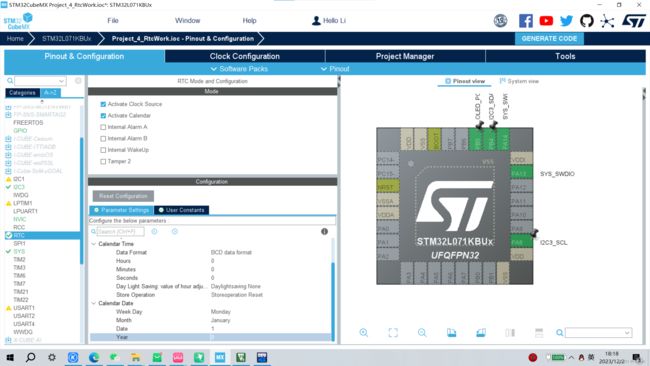蓝桥杯物联网竞赛_STM32L071_6_RTC显示
作用:
RTC在STM32微控制器中通常由一个独立的低功耗晶振和相关的寄存器组成。它可以独立于主处理器运行,即使在系统电源关闭的情况下(需要备用纽扣电池),也能继续计时和记录日期。注意:RTC是芯片内部的功能,并没有和GPIO相连。
CubMx配置:

keil配置:
由于RTC输出的数据为整型数据,要想在oled上显示要添加输出整数的功能,所以添加了如下函数:
uint32_t OLED_POW(uint32_t X, uint32_t Y){
uint32_t result = 1;
while(Y){
result = result * X;
Y --;
}
return result;
}
pow函数输出X^Y的值
void OLED_ShowNumber(unsigned char x, unsigned char y, uint32_t chr,unsigned char len, unsigned char size){
unsigned i = 0;
unsigned j = 0;
while(j < len){
OLED_ShowChar(x, y, chr / OLED_POW(10, len - 1 - i) % 10 + '0', size);
i ++;
j ++;
x += 8;
if(x > 120){
x = 0;
y += 2;
}
}
}
上述函数的作用是将整数拆解为单个字符输出如:
123拆解:
123 / 100 %10 = 1
123 / 10 % 10 = 2
123 / 1 % 10 = 3
Function以及main文件:
#include "Function.h"
#include "oled.h"
#include "i2c.h"
#include "rtc.h"
#include #ifndef __FUNCTION__
#define __FUNCTION__
void OLED_Write(unsigned char type, unsigned char data);
void Function_OledEnable(unsigned char ms);
unsigned char *Function_GetLocalTime(void);
unsigned char * Function_Decimalism(unsigned char * ArrayBin);
#endif
main.c:
#include "main.h"
#include "i2c.h"
#include "rtc.h"
#include "gpio.h"
#include "Function.h"
#include "oled.h"
void SystemClock_Config(void);
int main(void)
{
unsigned char * Time;
unsigned char * Temp;
HAL_Init();
SystemClock_Config();
MX_GPIO_Init();
MX_I2C3_Init();
MX_RTC_Init();
Function_OledEnable(50);
while (1)
{
/* USER CODE END WHILE */
Time = Function_GetLocalTime();
OLED_ShowString(0, 0, "TIME", 16);
OLED_ShowNumber(0, 2, Time[3], 2, 16);
OLED_ShowChar(16, 2, ':', 16);
OLED_ShowNumber(24, 2, Time[4], 2, 16);
OLED_ShowChar(40, 2, ':', 16);
OLED_ShowNumber(48, 2, Time[5], 2, 16);
/* USER CODE BEGIN 3 */
}
/* USER CODE END 3 */
}
void SystemClock_Config(void)
{
RCC_OscInitTypeDef RCC_OscInitStruct = {0};
RCC_ClkInitTypeDef RCC_ClkInitStruct = {0};
RCC_PeriphCLKInitTypeDef PeriphClkInit = {0};
__HAL_PWR_VOLTAGESCALING_CONFIG(PWR_REGULATOR_VOLTAGE_SCALE1);
RCC_OscInitStruct.OscillatorType = RCC_OSCILLATORTYPE_HSI|RCC_OSCILLATORTYPE_LSI;
RCC_OscInitStruct.HSIState = RCC_HSI_ON;
RCC_OscInitStruct.HSICalibrationValue = RCC_HSICALIBRATION_DEFAULT;
RCC_OscInitStruct.LSIState = RCC_LSI_ON;
RCC_OscInitStruct.PLL.PLLState = RCC_PLL_ON;
RCC_OscInitStruct.PLL.PLLSource = RCC_PLLSOURCE_HSI;
RCC_OscInitStruct.PLL.PLLMUL = RCC_PLLMUL_4;
RCC_OscInitStruct.PLL.PLLDIV = RCC_PLLDIV_2;
if (HAL_RCC_OscConfig(&RCC_OscInitStruct) != HAL_OK)
{
Error_Handler();
}
RCC_ClkInitStruct.ClockType = RCC_CLOCKTYPE_HCLK|RCC_CLOCKTYPE_SYSCLK
|RCC_CLOCKTYPE_PCLK1|RCC_CLOCKTYPE_PCLK2;
RCC_ClkInitStruct.SYSCLKSource = RCC_SYSCLKSOURCE_PLLCLK;
RCC_ClkInitStruct.AHBCLKDivider = RCC_SYSCLK_DIV1;
RCC_ClkInitStruct.APB1CLKDivider = RCC_HCLK_DIV1;
RCC_ClkInitStruct.APB2CLKDivider = RCC_HCLK_DIV1;
if (HAL_RCC_ClockConfig(&RCC_ClkInitStruct, FLASH_LATENCY_1) != HAL_OK)
{
Error_Handler();
}
PeriphClkInit.PeriphClockSelection = RCC_PERIPHCLK_I2C3|RCC_PERIPHCLK_RTC;
PeriphClkInit.I2c3ClockSelection = RCC_I2C3CLKSOURCE_PCLK1;
PeriphClkInit.RTCClockSelection = RCC_RTCCLKSOURCE_LSI;
if (HAL_RCCEx_PeriphCLKConfig(&PeriphClkInit) != HAL_OK)
{
Error_Handler();
}
}
void Error_Handler(void)
{
__disable_irq();
while (1)
{
}
}
